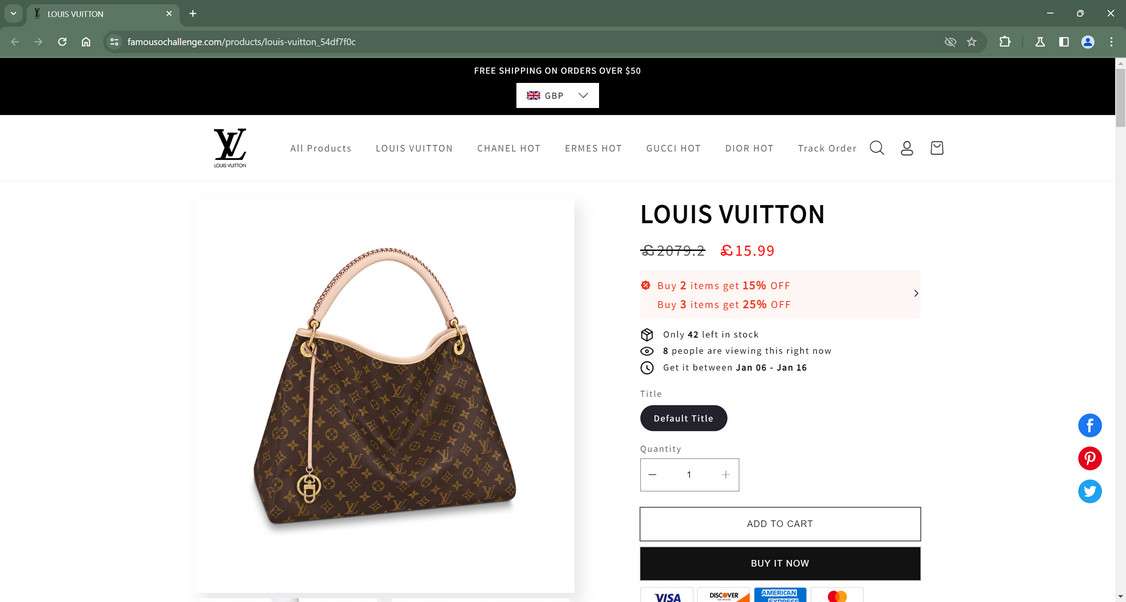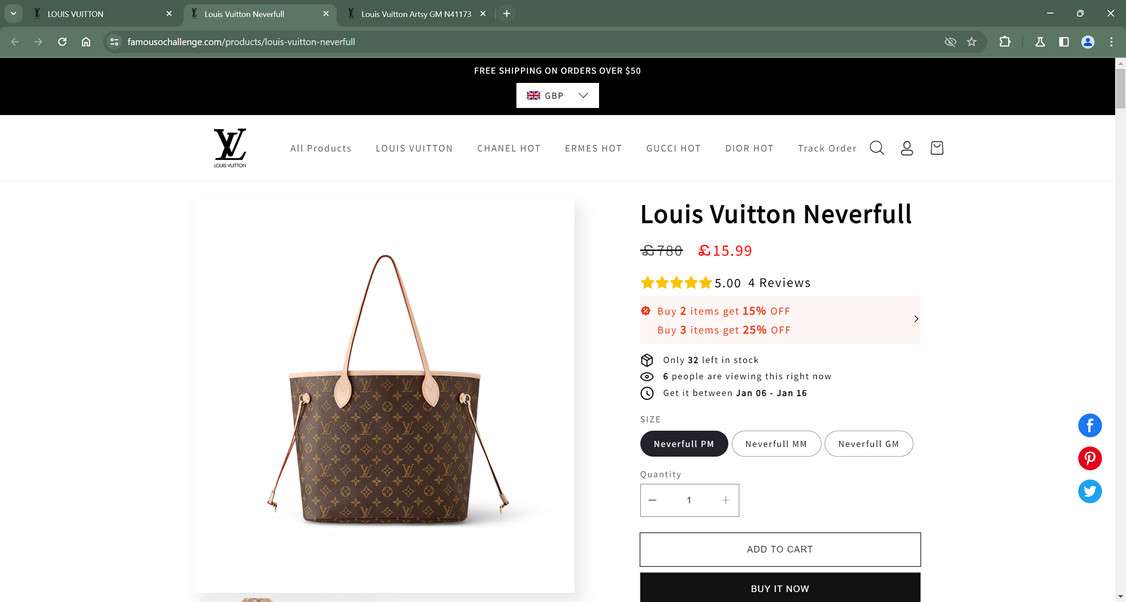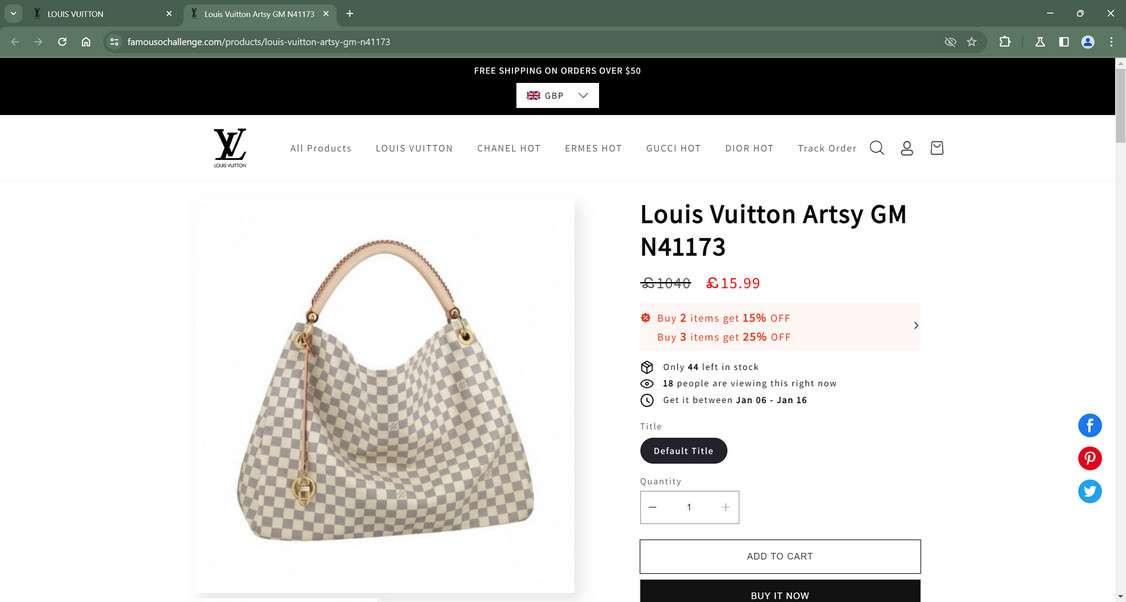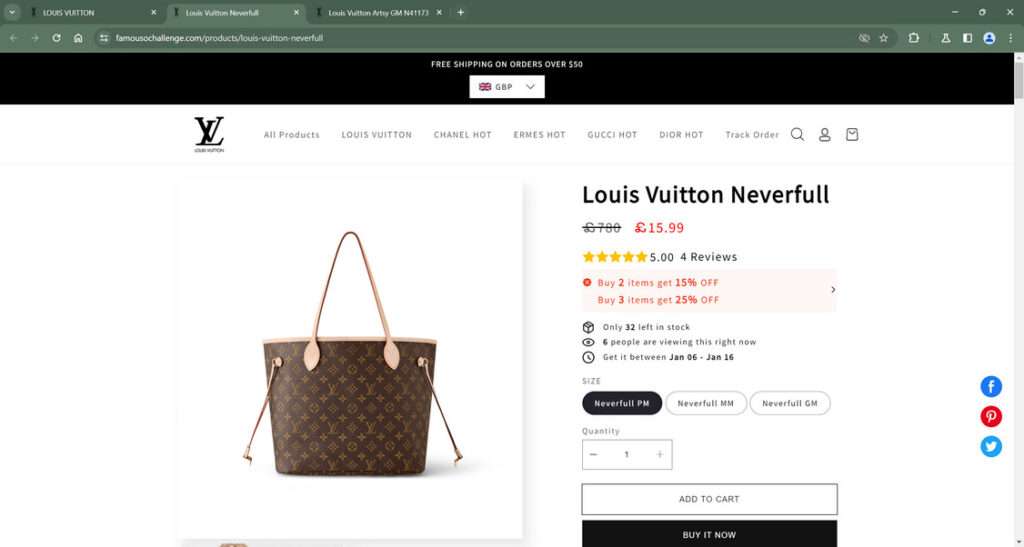Louis Vuitton is one of the most coveted and counterfeited luxury fashion brands in the world. Unfortunately, scammers are exploiting Louis Vuitton’s elite status to trick customers into buying from fake websites that mimic the real Louis Vuitton store.
This scam heavily promotes “clearance sales” with unbelievable discounts up to 90% off on social media platforms like Facebook and Instagram. The ads use Louis Vuitton’s logo and images to lure customers to fraudulent shopping websites. However, the deeply discounted Louis Vuitton products advertised simply do not exist – victims receive nothing after purchase or extremely low-quality counterfeit items.
This article will provide an in-depth look at how the Louis Vuitton clearance sale scam works, tips to identify fake LV websites, what to do if you fell victim, and how to protect yourself from these retail scams.



This Article Contains:
Overview of the Louis Vuitton 90% Off Clearance Sale Scam
The Louis Vuitton clearance sale scam operates by setting up elaborate fake e-commerce stores posing as the real luxury fashion house. Scammers build sophisticated websites with Louis Vuitton’s iconic logo, product images, and overall brand aesthetics throughout.
To attract customers, they heavily promote “blowout” clearance sales with absurd discounts up to 90% off on social media. The ads even mention real Louis Vuitton handbags like the Neverfull and Speedy next to unbelievable prices like $50 or $100 instead of over $1000.
If a person clicks on one of these ads, they are taken to a scam Louis Vuitton website to purchase products at incredible bargain prices. However, this is a fraudulent store intent only on stealing money and personal information.

Victims will receive nothing after payment or at best, a cheap counterfeit item. The scammers quickly take down their fake sites once enough orders come through. Then they reuse the scheme all over again under a new domain name.
This scam takes advantage of Louis Vuitton’s elite status and the temptation of huge discounts on normally astronomically priced products. But there are ways to identify and avoid these elaborate fake LV websites.
How the Fraudulent Louis Vuitton Websites Operate
The fake Louis Vuitton sites look impressively realistic on the surface but use deceptive tactics:
- Domain names – The urls seem valid but contain subtle oddities or errors.
- Branding – Louis Vuitton’s iconic logos, product images, and graphics are used extensively throughout each site.
- Content – Product descriptions, policies, and other text are either fully plagiarized or creatively fabricated.
- Pricing – Handbags, accessories, and items are listed at implausibly low prices like 90%+ off retail using pressure tactics.
- Checkout – Payment forms and processors seem legitimate but are set up to steal financial information.
While the fake sites appear very realistic thanks to Louis Vuitton’s stolen branding and content, inspecting closely reveals their fraudulent nature.
How the Louis Vuitton Clearance Sale Scam Works Step-by-Step:
Here is an in-depth look at how this scam operates from promotion to purchase:
1. Promote Fake Sales on Social Media
The scam begins by running sponsored ads on platforms like Facebook, Instagram, and Google. The ads tout deals like “Louis Vuitton Bag Sale! Up to 90% off” and “Going out of business – clear out sale.”
Many feature Louis Vuitton handbags next to prices like $100, $250, or $500 instead of the usual four-figure retail cost. The ads also use urgency tactics like “Limited time only!” to prompt immediate action.

2. Drive Traffic to a Sophisticated Fake Louis Vuitton Website
When a user clicks on one of these social media ads, they are redirected to an elaborate fake Louis Vuitton website designed to mimic the real luxury shopping experience.
The site has the iconic LV logo and monogram branding all over. The product selection matches the Louis Vuitton catalog with detailed descriptions and images stolen from LouisVuitton.com.
But a closer look shows subtle signs it’s an illegitimate site, like the url domain containing an extra word or spelling errors. Still, the sophisticated design and branding aim to trick visitors.

3. Entice Customers With Huge Discounts on Luxury Products
The fake site displays insane discounts up to 90% off handbags, wallets, accessories, and other LV products. These prices are far below what any retailer sells luxury brands for.
For example, a $1500 Neverfull MM bag is advertised at $250 or a $3000 Capucines PM bag at $500. Countdown timers, limited quantity claims, and going out of business language creates urgency to buy immediately.
4. Complete the Checkout Process
If a customer adds items to their cart, the site has a typical checkout process requesting all order details including full name, shipping address, email, and payment information.
The payment options show legitimate providers like Visa, Mastercard, PayPal, Apple Pay, etc. But any transaction only leads to stolen financial data.
5. Receive No Product After Payment
Weeks later, victims who paid for Louis Vuitton products on these scam websites receive nothing in the mail.
The crooks take the money and close down the site once enough people complain. Then they reopen a new fake Louis Vuitton store and rerun the lucrative scam.
6. Credit Card and Identity Theft
Beyond just taking money for unsent orders, the scammers also gain all the personal and payment information entered at checkout.
Names, addresses, and especially credit card numbers are valuable on the black market and commonly used for identity theft. This makes it critical to avoid entering details into fake luxury brand websites promoting unrealistic discounts.
By capitalizing on Louis Vuitton’s elite reputation and the desire for huge savings on extravagant products, these fraudsters continue deceiving aspiring luxury shoppers who fall for the clearance sale ruse.
How to Spot Fake Louis Vuitton Websites – 8 Red Flags
With a discerning eye, you can detect the subtle but revealing characteristics that expose fraudulent Louis Vuitton shopping sites. Watch for these telltale signs that a website claiming to sell LV products is a scam:
1. Suspicious Domain Name
Inspect the url for oddities like misspellings, extra words added, or use of the wrong domain extension. LouisVuitton.com is the only legitimate site.
2. Missing Contact Information
There is no “Contact Us” page with a real physical address, customer service number, and other ways to reach the company. Often only a suspicious email address is provided.
3. Implausibly Low Prices
Any discounts over 50% off are highly dubious. Be very wary of prices like 90% off or $100 for a $3000 bag. Louis Vuitton rarely offers more than 20% off.
4. Familiar Looking Website Design
The layout, fonts, colors, navigation, and other elements mimic the real Louis Vuitton website to plagiarize the luxury shopping experience.
5. Fake Limited Time Messaging
Aggressive “Act Now!” messaging and countdown timers pressure buyers to purchase before scrutinizing the site more thoroughly.
6. Low-Quality Product Photos
Image resolution on handbags, accessories, and other items appears inconsistent, heavily edited, or sloppy upon close inspection.
7. Generous Return Policy
Detailed return policy information with lenient terms Louis Vuitton does not offer. This aims to falsely convey legitimacy.
8. Spelling and Grammar Issues
Typos, poorly translated text, and other writing errors throughout the site indicate lack of a professional operation.
Heightened awareness of these red flags helps identify fake LV sites attempting to scam visitors. Always inspect closely and lean on skepticism before providing payment information or data.
How to Identify the Scam on Social Media
The fake Louis Vuitton sales are promoted via sponsored posts and ads on Facebook, Instagram, TikTok and other platforms. Here’s how to recognize them:
Spotting the Scam on Facebook
Watch for Facebook ads using:
- Huge discounts like “Louis Vuitton Bag Sale! 90% off”
- Countdown timers and limited quantity tactics to spur urgency
- Louis Vuitton’s iconic logo and product images
- Links to odd domains instead of the real LouisVuitton.com
- Very little comments or reactions compared to the ad spend
Spotting the Scam on Instagram
Look for Instagram scam ads with:
- Unbelievable prices called out like “Neverfull just $250!”
- Captions with slogans like “Store Closing Sale!” and “Last chance!”
- Louis Vuitton’s signature branding and products
- A disproportionately low number of likes and comments
- No authentic non-ad content on the account
Spotting the Scam on TikTok
Identify fake TikTok ads using:
- Videos promoting clearance sales with messaging like “Up to 90% off!”
- Urgency tactics in captions pressing viewers to click before a deadline
- Louis Vuitton logos, bags, accessories, and text
- Links in bios and captions that divert to shady domains
- Very generic comment responses indicating bots/fake accounts
Apply extra scrutiny to unbelievable luxury goods discounts and sales events on social channels. Verify website legitimacy before clicking links or providing information.
What to Do if You Fell Victim to a Fake Louis Vuitton Website
If you placed an order on one of these sophisticated fake Louis Vuitton sites, here are the steps to take right away:
Immediately Notify Your Credit Card Company
Report the charges as fraudulent. Provide details on the scam website and that you never received the items ordered. Your credit card company will initiate a chargeback to reverse the payments.
Monitor Accounts Closely
Keep an eye out for any suspicious charges or activity indicating your financial information was compromised. Enable text alerts on accounts to stay updated in real-time.
Place Fraud Alert on Credit Bureau Profile
Contact one of the three major credit bureaus to place an initial 90-day fraud alert on your credit file. This flags your account and requires verifying identity for new lines of credit.
File Complaints with Authorities
Submit details on the Louis Vuitton scam website, payment methods, losses, and other relevant information to the FBI’s Internet Crime Complaint Center and the Federal Trade Commission.
Warn Friends and Followers
Post comments warning others about the scam on the social media ads and posts driving traffic to the fake site. Report the ads or accounts distributing them as fraudulent directly to the platforms.
How to Avoid Fake Louis Vuitton Online Sales Scams
Here are some tips and best practices to protect yourself from clearance sale scams involving luxury brands like Louis Vuitton:
- Stick to louisvuitton.com – Only purchase directly from LV’s official website to guarantee authenticity. Avoid any third parties.
- Beware unbelievable discounts – If the prices advertised seem drastically lower than Louis Vuitton’s normal retail costs, it is too good to be true.
- Research limited edition items – Scammers often exploit demand for rare LV products with fake sales. Verify any limited releases via official brand channels and media.
- Avoid new websites – Only trust well-established online retailers with long track records in luxury goods. Never provide payment info or data to unfamiliar sites.
- Read reviews – Check third-party consumer reviews and complaints to expose commonly scammed websites with fraudulent Louis Vuitton product listings.
- Use credit cards – Never enter debit card or direct bank account information on unfamiliar ecommerce sites. You can dispute credit charges with the card issuer.
While the promise of huge Louis Vuitton savings is enticing, always err on the side of caution and verify legitimacy when retail offers seem too good to be true. Your watchfulness can help avoid clearance sale scams.
Frequently Asked Questions About the Fake Louis Vuitton Sales
Many people have questions about the fraudulent Louis Vuitton websites promoting clearance sales and huge discounts. Here are answers to some common FAQs about this luxury goods scam.
Are the Louis Vuitton 90% off deals on Facebook real?
No. Any social media advertisements for Louis Vuitton clearance sales with discounts over 50% off are scams. Louis Vuitton rarely offers more than 20% discounts even during major sales events. Ignore and report any ads promoting 90% off or similar as fraudulent.
How can I tell if a Louis Vuitton website is fake?
Inspect the URL for odd spellings, extra words added, or the wrong domain extension. Also look for contact info pages missing key details, prices far below normal retail value, and no links to Louis Vuitton’s social media accounts.
What happens if I order from a fake Louis Vuitton website?
You will likely receive nothing after payment, or at best a low-quality counterfeit item rather than the luxury product ordered. The scammers simply pocket your money and use any stolen financial information for fraud.
Can I get a refund if I purchase from a scam website?
If you paid by credit card you have a strong ability to dispute the charges as fraudulent and recover lost funds. Debit cards and wire transfers offer less purchase protection and recourse for obtaining refunds.
How do I report a fake Louis Vuitton website?
Contact Louis Vuitton directly to notify them of scam websites misusing their brand name and intellectual property without authorization. You can also file a complaint with the FBI’s Internet Crime Complaint Center.
Does Louis Vuitton run clearance sales on its website?
No. Louis Vuitton does not offer widespread clearance sales or deep discounts on its official website. Limited offers may run during the holiday season but are rarely over 20% off. Be very suspicious of any advertised blowout LV sales.
How can I avoid the fake Louis Vuitton sale scams?
Only purchase from LouisVuitton.com or directly from an authorized brick and mortar boutique location. Never provide payment information to unfamiliar third-party websites, especially with unrealistic discount pricing. Use caution and verify legitimacy to avoid being scammed.
Apply heightened scrutiny to avoid falling victim to unbelievable Louis Vuitton limited-time sales and clearance deals. Verify website legitimacy through contacting LV and trusting your instincts.
The Bottom Line
Luxury brands like Louis Vuitton carry prestige and price tags that scammers seek to exploit with sophisticated fake ecommerce stores claiming to offer clearance sales with extreme discounts. By copying LV’s iconic branding and running social media ads portraying dramatic savings, they lure aspirational shoppers into providing payment and personal information that only leads to stolen data and no products delivered.
However, a skeptical eye for unbelievable prices inconsistent with a brand’s image, missing contact information, and other red flags can help expose fraudulent websites impersonating legitimate retailers. Avoid falling victim to clearance sale scams by only purchasing luxury products directly from official brand channels and being wary of deals that seem unrealistic. Your caution is the best defense against these creative online retail ruses.










